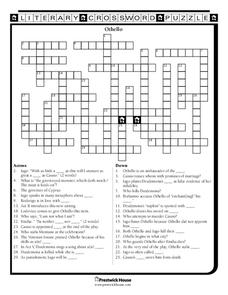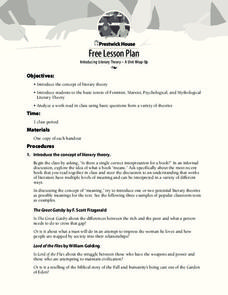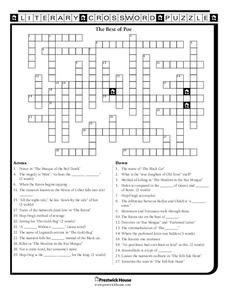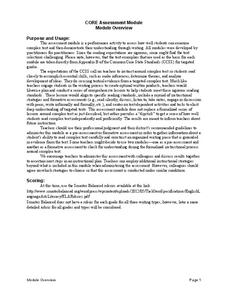Prestwick House
Julius Caesar
Learners won't consider a practice crossword puzzle on Shakespeare's Julius Caesar proves to be the unkindest cut of all. As they complete the puzzle, high schoolers review key concepts and characters from the play, checking both reading...
Prestwick House
Romeo and Juliet
What is the setting of Romeo and Juliet? Who is the rich count who wants to marry Juliet? The 24 clues in a crossword puzzle test readers' knowledge of the events in Shakespeare's famous play of two young star-crossed lovers.
Prestwick House
Othello
Oh, beware, reader of the clues in a Othello crossword puzzle. What you know of Shakespeare's tragic tale of the Moor, his wife Desdemona, and the manipulative Iago, you know. Or you just might have to use the text of Othello to find the...
Prestwick House
Of Mice and Men
What is Lennie Small's dream job? What's the future George imagines? Readers of Of Mice and Men must identify character and events from John Steinbeck's novella about the friendship of two California migrant workers.
Prestwick House
A Midsummer Night’s Dream
Lovers, madmen, and readers of A Midsummer Night's Dream will need seething brains to complete a crossword puzzle designed for Shakespeare's engaging comedy.
Prestwick House
Fahrenheit 451
Readers will be burning to attack a crossword puzzle based on Ray Bradbury's dystopian classic, Fahrenheit 451. They must fill in the missing words in passages drawn from the novel and identify characters.
Prestwick House
Macbeth
Double the enjoyment of the Scottish play with a crossword puzzle based on Shakespeare's Macbeth. The activity tasks readers to identify characters and events and to fill in the missing words from Shakespeare's tragedy about the...
Prestwick House
The Crucible
Characters and events in The Crucible provide the clues for a crossword puzzle that asks readers to demonstrate their knowledge of Arthur Miller's allegorical play.
Prestwick House
Introducing Literary Theory – A Unit Wrap-Up
Literary theories are lenses through which a text may be analyzed. The question in this lesson plan is how a particular literary lens can influence the reader's view of the text.
Prestwick House
Death of a Salesman
Arthur Miller's work of American tragedy and frustration is as relevant today as the first day it premiered on stage. Learners review character names and details from Death of a Salesman with a crossword puzzle that contains 27 clues.
Prestwick House
The Best of Poe
A chilling look of Edgar Allan Poe's works may not be a dream within a dream, but it's certainly a review within a crossword puzzle. Look down and across to find references to "The Raven," "The Tell-Tale Heart," "The Black Cat," and "The...
Fluence Learning
Writing About Literature Shakespeare and Plutarch
The Oscar for the Best Adapted Screenplay acknowledges a writer's excellence in adapting material found in another source. What do your class members know about adapted resources? Find out with an assessment that asks readers to compare...
Houghton Mifflin Harcourt
The Old Man and the Sea Ernest Hemingway
Accompany a reading of Ernest Hemingway's The Old Man and the Sea with a thorough literature packet. Although the materials are meant to prepare readers for a timed essay, the background information and the activities are sure to engage...
North Penn School District
The Catcher in the Rye
Learning more about Holden Caulfield's worldview and state of mind is an integral part of understanding J.D. Salinger's The Catcher in the Rye. A thorough packet of materials pertaining to the unit allow learners to build prior knowledge...
California Education Partners
Grapes of Wrath
To demonstrate their ability to comprehend complex text, individuals analyze the details, syntax, and diction John Steinbeck uses in a passage from The Grapes of Wrath to reveal the develop and evolution of Mae's character.
California Education Partners
Women
Alice Walker's poem "Women" provides ninth graders the opportunity to demonstrate their ability to identify how a writer's choice of syntax and diction contribute to the development of the theme of the work.
West Jefferson High School
The Novel — Honor
For classes tackling To Kill a Mockingbird, this lesson plan sets readers up for discussions or essay writing with questions and prompts. The prompts encourage individuals to explore beyond the novel itself, looking at photographs from...
Penguin Books
Teacher's Guide: Kindred by Octavia E. Butler
A teacher's guide for Kindred provides instructors with a wealth of materials to enrich either a full-class reading or independent study of Octavia E. Butler's popular science fiction novel. The activities are designed to encourage...
Newspaper in Education
The Iliad: A Young Reader Adventure
Is The Iliad part of your curriculum? Check out a resource that offers something for those new to teaching the classic and those with lots of experience using Homer's epic. Plot summaries, discussion questions, activities abound in this...
Penguin Books
A Teacher's Guide to the Signet Classic Edition of Beowulf
Beowulf, the Old English epic hero, comes alive again in the activities found in a teacher's guide designed to accompany a reading of the classic poem.
Polar Trec
Calorimetry Lab
Young people between the ages of 11–13 need on average about 2,000 calories per day. Within the lab, groups learn about calorimetry and respiration. They explore how it pertains to humans and animals living the Arctic where cold...
EngageNY
Grade 9 ELA Module 1: Unit 3, Lesson 20
The final session in this 20-lesson plan unit asks individuals to use their Quick Writes, discussion notes, worksheets, and annotated text to craft and support a claim about how Shakespeare develops either Romeo or Juliet as tragic heroes.
EngageNY
Grade 9 ELA Module 1: Unit 3, Lesson 19
To prepare for the unit's final assessment essay, class members collaborate to find evidence that reveals Romeo and Juliet as tragic heroes.
EngageNY
Grade 9 ELA Module 1: Unit 3, Lesson 18
Why is Romeo and Juliet considered a tragedy? Class members conclude their reading of the play, focusing on the final lines of Act 5, scene 3. They also consider how Shakespeare structures the text, orders events, and manipulates time to...

























